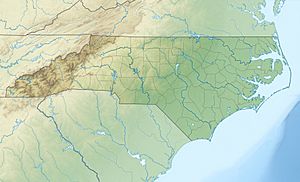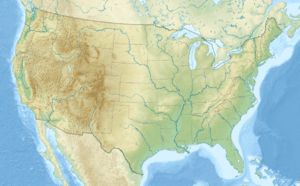Caddle Creek (Ararat River tributary) facts for kids
Quick facts for kids Caddle Creek |
|
|---|---|
|
Location of Caddle Creek mouth
|
|
| Other name(s) | Tributary to Ararat River |
| Country | United States |
| State | North Carolina |
| County | Surry |
| Physical characteristics | |
| Main source | Fisher River divide about 0.5 miles east of Turners Mountain 1,260 ft (380 m) 36°25′27″N 080°39′21″W / 36.42417°N 80.65583°W |
| River mouth | Ararat River about 2 miles southeast of White Plains, North Carolina 930 ft (280 m) 36°26′23″N 080°36′09″W / 36.43972°N 80.60250°W |
| Length | 4.02 mi (6.47 km) |
| Basin features | |
| Progression | east-northeast |
| River system | Yadkin River |
| Basin size | 3.85 square miles (10.0 km2) |
| Tributaries |
|
| Bridges | Simpson Mill Road, Hickman Hollow Trail, Old Creed Road, Siloam Road |
Caddle Creek is a small stream, about 4 miles (6.47 km) long, located in Surry County, North Carolina. It's known as a "second-order tributary," which means it flows into a larger river, the Ararat River.
Contents
About Caddle Creek
Caddle Creek is a natural waterway that plays a part in the local environment of Surry County. It's one of many creeks and rivers that make up the water system in this part of North Carolina.
Other Names for the Creek
Over time, some places get different names. Caddle Creek has also been known by a couple of other names in the past. These include Cadel Creek and Cadels Creek.
Where Caddle Creek Starts and Ends
Caddle Creek begins its journey in an area called the Fisher River divide. This is a higher elevation point, about half a mile east of a place known as Turner Mountain.
From its starting point, the creek flows generally towards the east-northeast. It continues its path until it meets the Ararat River. This meeting point is about 2 miles (3.2 km) southeast of the town of White Plains, North Carolina.
The Area Caddle Creek Drains
Every stream and river collects water from a specific area around it. This area is called a watershed. Caddle Creek's watershed covers about 3.85 square miles (9.97 sq km).
This area gets a good amount of rain each year, about 47.8 inches (121.4 cm). A large part of the watershed, about 51%, is covered by forests. This helps keep the water clean and supports local wildlife.



